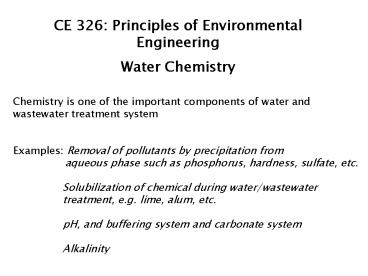CE 326: Principles of Environmental Engineering PowerPoint PPT Presentation
1 / 10
Title: CE 326: Principles of Environmental Engineering
1
CE 326 Principles of Environmental
Engineering Water Chemistry
Chemistry is one of the important components of
water and wastewater treatment
system Examples Removal of pollutants by
precipitation from aqueous phase
such as phosphorus, hardness, sulfate, etc.
Solubilization of chemical during
water/wastewater treatment, e.g. lime,
alum, etc. pH, and buffering system
and carbonate system Alkalinity
2
Precipitation and Solubility Precipitation
Dissolved ions can react with each other and form
a solid compounds and settle down at the bottom
of aqueous phase. This phase-change reaction of
dissolved to solid state is called a
precipitation. e.g. Ca2 CO32- ? CaCO3? ---
Hardness removal Ca2 PO42- ? Ca3(PO4)2? ---
Phosphorus removal Ba2 SO42- ? BaSO4? ---
Sulfate removal Solubility Degree of
dissolution of compounds in aqueous phase is
known as solubility. For compounds/chemicals to
be effective in water/wastewater treatment, they
should be highly soluble. Some Compounds are
more soluble and some are less. For example,
Lime, AgCl are rarely soluble compounds whereas
NaCl, NaHCO3 are highly soluble.
3
Solubility Product
The degree of the solubility of any compound can
be represented by the following general
reaction AaBb (S) ? aAb bBa-
Ca3(PO4)2 ? 3Ca2 2PO43-
In above equation, the products of activity of
both ions is always a constant for a given
compound at a given temperature, i.e. Aa
B-b Ksp Ca23 PO43-2 Ksp The
constant Ksp is known as solubility product
constant.
4
What Does Solubility Product Mean??
- When Aa B-b lt Ksp, the compound continue to
solubilize and - the solubilization continue to take place
until Aa B-b Ksp
2. When Aa B-b gt Ksp, the compound will
start to precipitate
Based on Ks value, we can actually calculate the
solubility of any particular compound
e.g. for Ba2 SO42- S2 Ksp 1 x
10-10 Therefore, the solubility of BaSO4 is
1x10-5 M. whereas the solubility of CaF2is
1.96x10-4 M. So calcium fluoride is 20 times
more soluble than barium sulfate.
For Ca2 F-2 (S) (2S)2 Ksp 3 x 10-11
5
pH, and Buffering and Carbonate System
pH is the term used universally to express the
intensity of the acid or alkaline condition of
aqueous phase. More precisely, acids are defined
as those compounds that releases proton (H)
whereas bases are those compounds that accept
protons (H). Thus, pH is the measurement of
hydrogen ion activity. Pure water dissociates to
yield a conc. of hydrogen ions equal to 10-7
moles/L H2O ? H OH- The water
dissociation produces also one mole hydroxyl ion
for each mole of hydrogen ion. Therefore, H
OH- 10-7 The equilibrium eq. for pure water
is H OH- Kw 10-7x10-7
10-14 pH is usually expressed as log 1/H or
log H Thus, pH POH 14 with 7 being the
neutral value. If we know Hydrogen ion
concentration, we can calculate pH.
What is the pH for H 10-4.8 ?
6
0
Sulfuric acid Hydrochloric acid Nitric acid
Acid range
7
Sodium hydroxide Sodium bicarbonate Calcium
hydroxide
Alkaline range
14
7
Buffering and Carbonate System
An aqueous solution that resists changes in pH
when acid or base is added is known to have
sufficient buffering capacity. Atmospheric carbon
dioxide produces a natural buffer and is the
Most important buffer system in water and
wastewater treatment CO2(g) ? CO2 (aq)
H2O (1) dissolved CO2 CO2(aq) H2O ?
H2CO3 (2) carbonic acid H2CO3 ? H
HCO3- (3) bicarbonate HCO3- ? H
CO32- (4) carbonate CO2 in solution CO2(aq)
is in equilibrium with atmospheric CO2(g). The
change in any components in eqs. (4), (3), or (2)
will cause CO2 either to be released or to
dissolve into solution. If acid is added H
increases in the system. This derives eq. (4)
towards left thereby forming more bicarbonate.
The bicarbonate Further combines with H and
forms carbonic acid eq. (3), which dissociates
to CO2 and water. The excess carbon dioxide is
then released to atmosphere.
8
Buffering and Carbonate System
CO2(g) ? CO2 (aq) H2O (1) dissolved
CO2 CO2(aq) H2O ? H2CO3 (2) carbonic
acid H2CO3 ? H HCO3- (3)
bicarbonate HCO3- ? H CO32- (4)
carbonate If base is added H is consumed
increases in the system. This derives above eqs.
towards right direction. This therefore converts
the gaseous carbon dioxide to carbonate. If CO2
is bubbled into the system The above reactions
shift towards right due to formation of carbonic
acids. This is because CO2 will combine with
water. The pH will decrease. If CO2 is stripped
out from the system The above reactions shift
towards left. CO2 is removed from the solution.
The pH will increase
9
Buffering and Carbonate System
H2CO3 ? H HCO3- pKa1 6.35 at 25o C HCO3-
? H CO32- pKa2 10.33 at 25oC
10
Alkalinity
Alkalinity is defined as the sum of all
titratable bases down to about pH 4.5. Alkalinity
thus measures its capacity to neutralize acid. In
most aqueous system, the alkalinity contributions
are from carbonate system, and any free H or
OH-. Mathematically, alkalinity can be determined
by Alkalinity HCO3- 2CO32-OH- H
(5) Alkalinity provides a buffering capacity
to aqueous system. The higher the alkalinity is,
the higher the buffering capacity against pH
changes. In above equation, the alkalinity is
expressed as moles/L, however, in environmental
engineering, alkalinity is commonly expressed as
mg/L as CaCO3. mg/L as CaCO3 (mg/L of species)
EW of CaCO3/EW of species Equivalent weight
(EW) Molecular weight/number of charge See
Example 3.8

